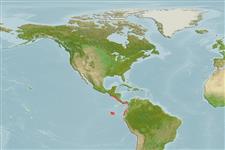Teleostei (teleosts) >
Lophiiformes (Anglerfishes) >
Lophiidae (Goosefishes)
Etymology: Lophiodes: Greek, lophos = crest + Greek, suffix oides = similar to (Ref. 45335).
More on author: Garman.
Environment: milieu / climate zone / depth range / distribution range
Ecology
Marine; demersal; depth range 120 - 475 m (Ref. 9538). Tropical; 14°N - 5°S
Eastern Pacific: California, USA (Ref. 9538) to Chile (Ref. 9068).
Size / Weight / Age
Maturity: Lm ? range ? - ? cm
Max length : 30.0 cm TL male/unsexed; (Ref. 9538); common length : 20.0 cm TL male/unsexed; (Ref. 9538)
Short description
Identification keys | Morphology | Morphometrics
Adults are benthic on the continental shelf and the upper regions of the continental slope (Ref. 9538). Juveniles are pelagic (Ref. 9538). Oviparous, with planktonic larvae (Ref. 36490). Eggs are presumably contained in floating gelatinous rafts (Ref. 36490). Probably caught as a by-catch of trawl fishing (Ref. 9538).
Life cycle and mating behavior
Maturity | Reproduction | Spawning | Eggs | Fecundity | Larvae
Caruso, J.H., 1995. Lophiidae. Rapes. p. 1227-1230. In W. Fischer, F. Krupp, W. Schneider, C. Sommer, K.E. Carpenter and V. Niem (eds.) Guia FAO para Identification de Especies para lo Fines de la Pesca. Pacifico Centro-Oriental. 3 Vols. FAO, Rome. (Ref. 9538)
IUCN Red List Status (Ref. 130435: Version 2024-1)
Threat to humans
Harmless
Human uses
Tools
Special reports
Download XML
Internet sources
Estimates based on models
Preferred temperature (Ref.
123201): 11.8 - 14.2, mean 13.5 °C (based on 9 cells).
Phylogenetic diversity index (Ref.
82804): PD
50 = 0.5000 [Uniqueness, from 0.5 = low to 2.0 = high].
Bayesian length-weight: a=0.02344 (0.01304 - 0.04215), b=3.08 (2.91 - 3.25), in cm total length, based on LWR estimates for this species & (Sub)family-body (Ref.
93245).
Trophic level (Ref.
69278): 4.0 ±0.66 se; based on food items.
Resilience (Ref.
120179): Medium, minimum population doubling time 1.4 - 4.4 years (Preliminary K or Fecundity.).
Fishing Vulnerability (Ref.
59153): Low vulnerability (20 of 100).
